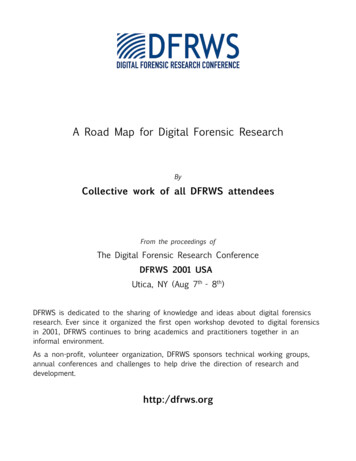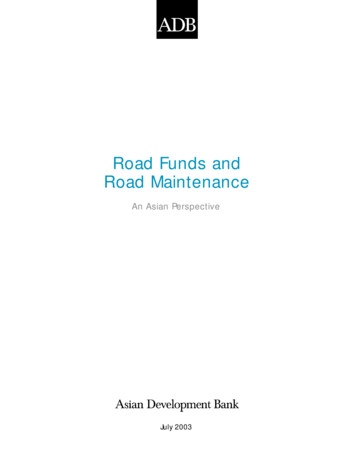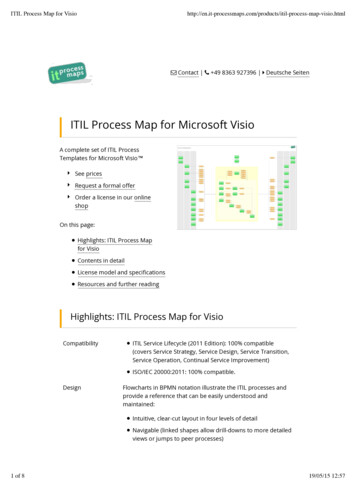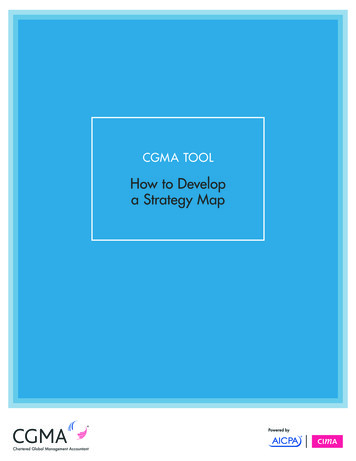
Transcription
DIGITAL FORENSIC RESEARCH CONFERENCEA Road Map for Digital Forensic ResearchByCollective work of all DFRWS attendeesFrom the proceedings ofThe Digital Forensic Research ConferenceDFRWS 2001 USAUtica, NY (Aug 7th - 8th)DFRWS is dedicated to the sharing of knowledge and ideas about digital forensicsresearch. Ever since it organized the first open workshop devoted to digital forensicsin 2001, DFRWS continues to bring academics and practitioners together in aninformal environment.As a non-profit, volunteer organization, DFRWS sponsors technical working groups,annual conferences and challenges to help drive the direction of research anddevelopment.http:/dfrws.org
DT R - T 0 0 1- 0 1 F I N ALDFRW S T ECHN IC A L R E PO RTA Road Map for Digital Forensic ResearchReport From the First Digital Forensic Research Workshop (DFRWS)August 7-8, 2001Utica, New YorkSponsored By AFRL/IFGBAir Force Research Laboratory, Rome Research SiteInformation Directorate/Defensive Information Warfare BranchDocument authored from the collective work of all DFRWS attendees by: Gary Palmer, The MITRE CorporationNovember 6th, 2001 - FinalApproved For Public Release
Executive SummaryThe search for truth is in one way hard and in another easy - for it is evident that no one of us can master itfully, nor miss it wholly. Each one if us adds a little to our knowledge of nature, and from all the factsassembled arises a certain grandeur.AristotleOn August 7-8, 2001, the first Digital Forensic Research Workshop was held in Utica,New York. Over 50 university researchers, computer forensic examiners, and analystsattended the workshop.The Air Force Research Laboratory, InformationDirectorate/Defensive Information Warfare Branch, sponsored the workshop from the RomeResearch Site in Rome, New York. This gathering was intended to spark discussion amongacademics and practitioners with experience and interest in the field of Digital ForensicScience. The objectives of this first workshop were to begin forming a community ofinterested individuals and to start a meaningful dialog for defining the field and identifyingthe difficult, high-priority challenges that lie ahead. The major goal was to establish aresearch community that would apply the scientific method in finding focused near-termsolutions driven by practitioner requirements and addressing longer term needs, consideringbut not constrained by current paradigms. The results of this and future gatherings areintended for wide distribution among sponsors and consumers of digital forensic technology,such as military, civilian, and law enforcement professionals.The workshop discussions were initiated by presentations from five invited keynotespeakers, each representing a different perspective related to forensic analysis. Views onDigital Forensic Science and supporting research from law enforcement, military operations,infrastructure protection, commercial development, academia, and government werepresented on the morning of the first workshop day. These presentations provided a broadspectrum of information for attendees that would form the basis of the workshop discussionsto follow.The remainder of the workshop was devoted to group discussions on the following fourtopics chosen both to define this new field of Digital Forensic Science and to address highpriority technology challenges:1. Define a Framework for Digital Forensic Science2. Discuss the Trustworthiness of Digital Evidence3. Discuss Detection and Recovery of Hidden Data4. Discuss Digital Forensic Science in Networked Environments (Network Forensics)Attendees divided into five groups, discussed each topic, and then briefed findings to allpresent. The Workshop 1 discussion resulted in a new definition of Digital Forensic Scienceiii
that incorporates objectives of analysis beyond just those used by law enforcement. TheWorkshop 2 discussion concluded that digital evidence was not inherently untrustworthy butthat additional research in underlying technologies was needed to attain the desired integrityand fidelity. Workshop 3 was a fascinating educational experience as many experts in thefield of Steganography (a technique whereby messages of many types may be embeddedwithin still images and video with little or no visible effect) explained ongoing research andidentified additional areas needing coverage. Finally, the Workshop 4 discussions produceda working definition of Network Forensics as well as identified several major areas ofconcern that could be candidates for fundamental and applied research.This document contains the DFRWS proceedings. It is intended to show those inauthority with interest in and concerns about the future of law enforcement, intelligence, andinformation collection and analysis where expertise in Digital Forensic Science exists andhow those experts see the problems that lie ahead. To that end, this document serves as aninformative foundation for all future work in this area. In the interests of summarizing theresults, the Road Map has been included in summary form with a glimpse of a possibletimeline for the research the DFRWS would like to perform. This Road Map can be found inAppendix A. Appendix B lists workshop attendees and contact information.DFRWS attendees consider this initial meeting a great first step toward discovery,understanding, and research in the new discipline of Digital Forensic Science. Also, thetragic events of September 11, 2001, reinforce the critical need for further research in thisfield. The organization will continue to sponsor additional workshops and focusedgatherings as long as there are challenges to address and community interest remains keen.The DFRWS will continue to maintain and enhance the organization’s web site (TBD),where members may interact via the pages and the DFRWS list server.iv
Table of ContentsPURPOSE. 1INTRODUCTION. 1WORKSHOP SCHEMA . 3DIGITAL FORENSIC RESEARCH PERSPECTIVES. 6“BIG COMPUTER FORENSIC CHALLENGES,” BY DR. EUGENE SPAFFORD . 7“A DEFENSIVE INFO OPS PERSPECTIVE ON FORENSIC ANALYSIS REQUIREMENTS,” BY CHARLES BOECKMAN . 8“DIGITAL FORENSIC TECHNOLOGIES: ARE WE OVERLOOKING KEY FUNDAMENTALS?,” BY CHET HOSMER . 10“DIGITAL FORENSICS,” BY DAVID BAKER . 11“ELECTRONIC CRIME TECHNOLOGY PROGRAM: NIJ/OS&T,” BY DR. JOHN HOYT . 12WORKSHOP DISCUSSIONS . 14WORKSHOP 1 - A FRAMEWORK FOR DIGITAL FORENSIC SCIENCE . 15The Definition. 16The Process . 17Building Expertise . 18WORKSHOP 2 - THE TRUSTWORTHINESS OF DIGITAL EVIDENCE . 20The Description . 20Issues . 21Research Solutions . 22WORKSHOP 3 - DETECTION AND RECOVERY OF HIDDEN DATA . 23The Definition. 23Hidden Data Placement . 24Trends in Concealment. 24Research in Detection and Recovery. 25WORKSHOP 4 - DIGITAL FORENSIC SCIENCE IN NETWORKED ENVIRONMENTS (NETWORK FORENSICS) . 27The Definition. 27Major Issues . 28Time . 28Performance . 28Complexity. 28Collection. 29Paradigm Distinctions . 29Collaboration . 30Legal Hurdles. 30Emerging Technologies . 30SUMMARY AND CONCLUSIONS. 32v
APPENDIX A – A DIGITAL FORENSIC ROAD MAP. 33BUILDING A FRAMEWORK FOR DIGITAL FORENSIC SCIENCE. 33Objective. 33Research Areas. 33Payoff . 33Timeline . 35ISSUES OF TRUST IN DIGITAL EVIDENCE . 35Objective. 35Research Areas. 35Payoff . 36Timeline . 36DETECTION AND RECOVERY OF HIDDEN DATA. 36Objective. 36Research Areas. 37Payoff . 37Timeline . 37DIGITAL FORENSIC SCIENCE IN NETWORKED ENVIRONMENTS (NETWORK FORENSICS) . 38Objective. 38Research Areas. 38Payoff . 39Timeline . 39APPENDIX B - ATTENDEES AND CONTACT INFORMATION . 40vi
List of FiguresFigurePageFigure 1 - Nucleus of Digital Forensic Research . 4Figure 2 - DFRWS Organizational Objectives . 5Figure 3 - Keynote Speakers and Forensic Perspective . 6Figure 4 - DFRWS Discussion Topics . 14Figure 5 - A Definition for Digital Forensic Science . 16Figure 6 - A Definition for Network Forensics . 27List of TablesTablePageTable 1 - Suitability Guidelines for Digital Forensic Research . 3Table 2 - Investigative Process for Digital Forensic Science . 17Table 3 - Sources of Expertise in Digital Forensic Science . 19Table 4 - Categories of Data Hiding . 24vii
PurposeThe laws of physics, with all their logical apparatus, still speak, however indirectly, about the objects of theworld.Ludwig Wittgenstein, Tractatus Logico-Philosophicus (6.3431)The purpose of this paper is to present the proceedings of the first Digital ForensicResearch Workshop (DFRWS), held in Utica, New York, and sponsored by the Air ForceResearch Laboratory, Information Directorate/Defensive Information Warfare Branch. Thegoal of the workshop was to provide a forum for a newly formed community of academicsand practitioners to share their knowledge on Digital Forensic Science. The intendedaudience is military, civilian, and law enforcement professionals who use forensic techniquesto uncover evidence from digital sources.IntroductionProviding accurate information derived through the use of proven and well-understoodmethodologies has always been the goal of traditional forensic analysis. Forensic Scienceapplied in courts of law has sought to use commonly applied techniques and tools only afterrigorous, repetitive testing and thorough scientific analysis. One only has to look at DNAanalysis to see evidence to support this statement. Most citizens today accept DNA evidencewithout question. To most this type of evidence is irrefutable and uncontestable. However,DNA didn’t just appear out of the blue. From all accounts it was first presented in U.S.courts in 1987,1 a full two years after Dr. Alec Jeffreys surmised that DNA could be used toidentify an individual from serological analysis. This discovery came 32 years after Watsonand Crick described the DNA molecule, which in turn followed the first indication that thissubstance existed by 84 years.2 The point here is not how long this process took but that itwas, in fact, a process. Discoveries built on the solid, repeatable finding of others. Factualdiscovery takes time and an insatiable desire for accuracy of results as well as precision inthe methodologies employed in its production. Without the rigorous process that leads to1The DNA Revolution, by Katherine /6.htm2Johann Friedrich Miescher, 1869, identified a weakly acidic substance of unknownfunction in the nuclei of human white blood cells. This substance would later be calleddeoxyribonucleic acid, or DNA. Milestones in DNA History, About ooks/SFTS/sidebarmilestone.html1
proven scientific discovery, decision-makers in the courts and elsewhere are left to rely onsupposition or worse yet intuition in the pursuit of justice.Because the courts are forums where information may persuade us to restrict or removeindividual liberties, they have proven to be a serious testing ground for scientific research.Even after all the rigorous research that preceded that first U.S. DNA case, the Florida courtstill held a pretrial hearing to assess the suitability of this new type of evidence. Before DNAevidence could be admitted, a decision-maker3 had to attempt to understand what this sciencerepresented and if he/she trusted it as proof that could support due process as charged by ourConstitution. Addressing suitability both in and out of the courts is at the heart of all ForensicScience, and it was, indeed, a key factor in discussions held during the workshop.Finally, although the tragic events of September 11, 2001, had not occurred at the time ofthe workshop, their impact on the field of Digital Forensic Science is especially applicable tothe future activities of this community. The result will be continued development ofimproved digital forensic tools and techniques.The remainder of this document is structured as follows. The next section describes theworkshop schema. The following two sections detail the briefings presented by keynotespeakers and summarize workshop discussions, respectively. Following a summary andconclusions, the document presents two appendices: Appendix A contains the DigitalForensic Road Map developed by workshop attendees, and Appendix B lists contactinformation.3In courts of law this is either the judge or the jury and is referred to as the “trier-of-fact.”2
Workshop SchemaThe workshop focused on three major areas in which forensic analysis is currently beingemployed in some form. Table 1 shows these areas, associated with a primary and secondaryobjective of forensic analysis as well as the temporal environment required for any analysisto be of use in supporting the primary objective.Table 1 - Suitability Guidelines for Digital Forensic ResearchAreaLaw EnforcementMilitary IW OperationsBusiness & IndustryPrimary ObjectiveSecondary ObjectiveProsecutionEnvironmentAfter the factContinuity of OperationsProsecutionReal TimeAvailability of ServiceProsecutionReal TimeInvestigators employ a different paradigm for each area when performing analyses. Thatis, law enforcement can’t act (or analyze) until there is sufficient reason to believe that acrime has occurred. Alternatively, military and civilian managers strive to anticipate, andtake action to thwart, anomalous activity before their mission or service is interrupted. Amilitary commander’s decision to pursue the secondary objective of prosecution may involvecomplex political criteria and coalition factors. Confronted with that same decision, civilianmanagement would, no doubt, have to weigh economic and financial outcomes beforeproceeding. All three areas listed in Table 1 are necessary to achieve total security for ournation, and all are actively pursuing forensic solutions to meet their disparate investigativegoals toward that end.Similarly, practitioners working in each area have different perspectives about whatdigital forensic research must offer. The intent here was to incorporate these different viewsinto workshop discussions to allow participants to hear views and opinions they may nothave otherwise considered. The hope is that the consideration of all perspectives will allowpractitioners to see the benefits of long-term research and allow the academic to performeffective research by identifying realistic applications. As shown in Figure 1, to be effective,fundamental digital forensic research must provide suitable solutions with the widest possibleapplicability to Homeland Security. To do that the focus must be the foundation science atthe root of the technologies we aim to analyze.3
LawEnforcementCourtsHomeland usiness &IndustryFigure 1 - Nucleus of Digital Forensic ResearchThe world is increasingly dependent on digital sources of information and thecomputerized systems and networks involved in data storage, processing, and transmission.This growing dependence drives development to advance required technology. Thisdevelopment results in technologies that will allow for data volumes unprecedented in ourhistory. The pranksters, criminals, terrorists, and other nefarious members of society havenot overlooked these facts. So words like cybercrime, cyberwar, and cyberterror havestarted to become more commonplace, and organizations are being formed to stop theactivity these terms define.The majority of current computer forensic analysis is focused on assisting the lawenforcement community. The criteria that define suitability for forensic evidence in this areaare the most clearly defined since computer forensic analysis must follow the same longstanding statutory and regulatory guidelines imposed on other, more traditional forensicdisciplines. Existing technologies and those that are evolving, in support of law enforcement,will come under increasing scrutiny as technical knowledge expands in scope. For thisreason, it is imperative that sound research steeped in the scientific method becomesfundamental to the discovery and enhancement of all tools and technologies employed toassist the courts, including digital forensic evidence.4
Forensic analysis in the civilian and military areas is moving quickly to find ways toidentify anomalous activity on networks and hosts. In these circles, you will more often hearterms like network forensics, virtual crime lab, remote forensics, or cyberforensics todescribe types of analysis. Here, prosecution is, at best, a secondary objective for theevidence or proof presented to decision-makers. Although they may decide to seek legalaction at a later time, their primary concerns are service availability and mission continuity.Also, managers, or those in authority, oversee clearly defined processes using finite resourceswithin strict budgets. Any decision they make to modify steps, reallocate resources, ordeviate from expected product delivery must have the most accurate information available.Therefore, the suitability criteria for forensic analysis here involve the production of highconfidence results in the shortest possible time or it serves little purpose in support ofprimary objectives.Fundamental digital forensic research will serve these and other paradigms should theyarise. The same core technologies are present for all computer and network users. Existingapplications for digital forensic analysis all require rigor to be of any use. They will benefitfrom repeated testing and published error rates to limit interpretive battles. They will gainwhen decision-makers can point to generally accepted findings to aid in the choices theymust make. To that end, this DFRWS was called to perform the tasks outlined in Figure 2. Initiate a dynamic community of experts from academia and practice Promote scholarly discussion related to digital forensic research and its application Involve experienced analysts and examiners from LE, military and civilian sectors Define core technologies that form the focus of useful research Establish a common lexicon so the community speaks the same language Engage in regular collaborative activity to keep focus sharp and interest highFigure 2 - DFRWS Organizational ObjectivesThese tasks form the beginnings of a mission statement for the DFRWS. The remainderof this paper documents the highlights of that event as they relate to the items listed above.The speaker presentations, workshop topics, workshop briefings, and material fromquestion-and-answer sessions are available at the DFRWS web site (TBD). Due to thesensitive nature of some of the material discussed, the site is configured for limited access.5
Digital Forensic Research PerspectivesNormal science does and must continually strive to bring theory and fact into closer agreement, and thatactivity can easily be seen as testing or as a search for confirmation or falsification.Thomas Kuhn, The Structure of Scientific RevolutionsWorkshop activities began with a series of briefings presented by invited speakers chosento represent those academic, operational, and commercial segments searching for clarity indigital forensic analysis. Speakers were asked to present a twenty-minute briefing outliningtheir perspective on the greatest challenges our maturing forensic research community wouldhave to face in the coming months and years as well as their thoughts on community focusthat would produce the greatest impact. The goals were to set the tone for workshopdiscussions and to create an atmosphere that addressed law enforcement’s needs duringgroup interactions but did not limit discussions to that area alone. The list of speakers, theiraffiliation, and associated perspectives are captured in Figure 3.SpeakerAssociationPerspectiveDr. Eugene SpaffordPurdue UniversityAcademic Research & GovernmentMr. Charles BoeckmanUSTRANSCOM (Mitre Corp.)DOD OperationsMr. Chet HosmerWetstone TechnologiesCommercial Tools DevelopmentMr. David BakerMitre Corp. (NIPC)Critical Infrastructure ProtectionDr. John HoytNational Institute of JusticeLaw EnforcementFigure 3 - Keynote Speakers and Forensic PerspectiveThe remainder of this section presents major highlights from each of these presentations.The full text and video4 for each speaker’s presentation have been approved for limitedpublic release and are available to authorized accounts at the DFRWS web site.4The video was created using Windows Media Tools and is therefore only playable usingWindows Media Player. Version 7 or higher is recommended.6
“Big Computer Forensic Challenges,” by Dr. Eugene SpaffordAcademic research in support of government, as well as commercial efforts to enhanceour analytical capabilities, often emphasizes technological results. Although this is importantit is not representative of a full-spectrum approach to solving the problems ahead. Researchmust address challenges in the procedural, social, and legal realms as well if we hope to craftsolutions that begin to fully “heal” rather than constantly “treat” our digital ills. This fullspectrum approach employs the following aspects: Technical: “Keeping up” is a major dilemma. Digital technology continues to changerapidly. Terabyte disks and decreasing time to market are but two symptoms thatcause investigators difficulty in applying currently available analytical tools. Add tothis the unknown trust level of tools in development5 and the lack of experience andtraining so prevalent today and the major problems become very clear. Procedural: Currently, digital forensic analysts must collect everything which in thedigital world leads to examination and scrutiny of volumes of data heretofore unheardof in support of investigations. Analytical procedures and protocols are notstandardized nor do practitioners and researchers use standard terminology. Social: Individual privacy and the collection and analysis needs of investigatorscontinue to collide. Uncertainty about the accuracy and efficacy of today’stechniques causes data to be saved for very long time periods, which utilizesresources that may be applied toward real problem solving rather than storage. Legal: We can create the most advanced technology possible, but if it doesn’t complywith the law it is moot.Research Focus: Work is needed to incorporate forensic hooks into tools rather thanuse our current band aid approach6 that produces point solution tools. We needtechnology that isn’t so ea
Nov 06, 2001 · DFRWS is dedicated to the sharing of knowledge and ideas about digital forensics research. Ever since it organized the first open workshop devoted to digital forensics in 2001, DFRWS continues to bring academics and practitioners together in an informal environment. As a non-profit, volunte











